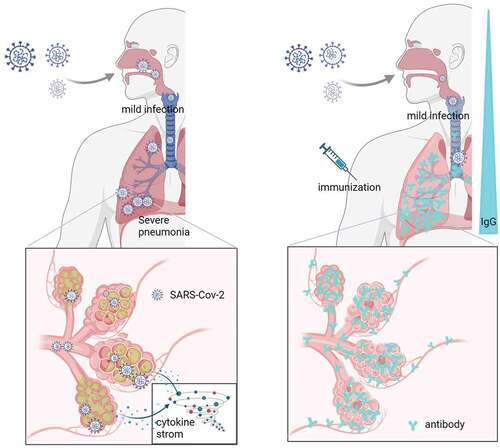Figures & data
Figure 1. The mechanism of infection of SARS-CoV-2 and protection offered by COVID-19 vaccine immunization.
Following binding to host cells, the SARS-CoV-2 virus initially infects the upper respiratory tract and causes flu-like symptoms, including dry cough, fatigue, and fever. Upon viral expansion to the lungs, patients develop viral pneumonia, characterized by pulmonary inflammation and coagulopathy. Cytokine storm can also occur to leading to alveolar epithelial damage, lung mucin secretion, and ventilatory dysfunction. Severe pneumonia is characterized by acute respiratory distress syndrome (ARDS) and an unfavorable clinical course (left).Following vaccination via the intramuscular route, neutralizing IgG antibodies are mainly induced in the circulation within the blood or lymph. An antibody gradient exists between the serum and the terminal of the upper respiratory tract (URT), as shown by the blue arrow. Only a small number of antibodies enter the airway lumen of the URT by physical exudation or active transport. This decrease in antibodies is in accordance with the decline in systemic antibodies, resulting in waning protection against virus infection of the URT. However, the antibody repertoire in the lung can efficiently inhibit viral attacks on the alveolar epithelium and capillary endothelium, limiting the occurrence of severe diseases. Systemic antibodies can also inhibit viremia and consequently prevent viral dissemination to other organs (right).

